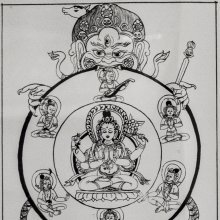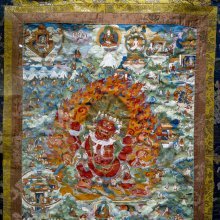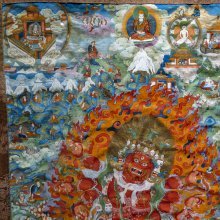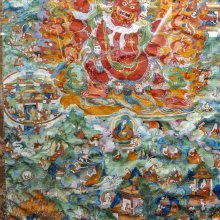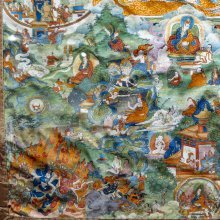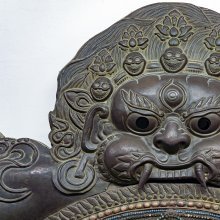Hayagriva, Hayagrīva, Haya-griva: 36 definitions
Introduction:
Hayagriva means something in Buddhism, Pali, Hinduism, Sanskrit, Jainism, Prakrit. If you want to know the exact meaning, history, etymology or English translation of this term then check out the descriptions on this page. Add your comment or reference to a book if you want to contribute to this summary article.
Images (photo gallery)
(+19 more images available)
In Hinduism
Purana and Itihasa (epic history)
Source: Wisdom Library: PurāṇasHayagrīva (हयग्रीव, “the horse-faced”):—Another name for Janārdana Mādhava (‘the Lord of all’) after his head was severed out of His body, according to the Devī-bhāgavata-purāṇa (Ch. 5 - The narrative of Hayagrīva). He is described as the ‘cause of all causes’ and Ādi Deva Jagannath (‘Lord of the universe’).
Source: archive.org: The Garuda puranamA Hayagriva stone is of the shape of a goad.
Source: archive.org: Puranic Encyclopedia1) Hayagrīva (हयग्रीव).—An Asura, the son of Kaśyapaprajāpati by his wife Danu. (Vālmīki Rāmāyaṇa, Araṇyakāṇḍa, Canto 14).
As a child the Asura began tapas on the banks of river Sarasvatī, and after a thousand years Devī appeared and asked him to choose any boon he wanted, and he wanted to become invincible by Devas and Asuras, and also deathless. When Devī told him that such a boon was out of question, he wanted the boon that he (Hayagrīva) should not be killed by anyone but by a Hayagrīva (one with the horse’s neck). Devī granted him the boon.
Hayagrīva, who became haughty and overconfident on receiving such a boon, went about the three worlds troubling good people, and at last he clashed with the Devas. As he could be killed only by one with the head of a horse the combined attack of Mahāviṣṇu and the Devas did not succeed in defeating him and Mahāviṣṇu decided to rest for some time to recoup himself from weariness. During his rest his head was hit by the end of his own bow and the head was severed from the trunk. Mahāviṣṇu replaced the head thus lost with that of a horse and killed Hayagrīva in fight. (For details see Cital). (See full article at Story of Hayagrīva from the Puranic encyclopaedia by Vettam Mani)
2) Hayagrīva (हयग्रीव).—An asura who guarded the kingdom of Narakāsura. He was killed by Śrī Kṛṣṇa, (Udyoga Parva, Chapter 130 Verse 50).
3) Hayagrīva (हयग्रीव).—A King born in the Videha dynasty. (Udyoga Parva, Chapter 74, Verse 15).
4) Hayagrīva (हयग्रीव).—A saintly king. Though he defeated his enemies, yet, as he had no backing and support, he was finally killed. The story of Hayagrīva was told by Vyāsa to teach Dharmaputra the lesson that even the greatest of heroes requires the support of others. Though killed, Hayagrīva secured a place in heaven. (Śānti Parva, Chapter 24, Verse 23).
5) Hayagrīva (हयग्रीव).—An incarnation of Viṣṇu. In Vedic literature:—In Vedic literature incarnation as Hayagrīva is attributed not to Viṣṇu, but to Yajña. But the Taittirīya āraṇyaka depicts yajña as a protoform of Viṣṇu. The inference that may be drawn from the above is that the root of the Hayagrīva story detailed in Vedic and Purāṇic literature is one and the same.
About the Hayagrīva incarnation the Pañcaviṃsabrāhmaṇa contains the following story.
Agni, Indra, Vāyu and Yajña (Viṣṇu) once began a yajña on the understanding that the havirbhāga obtained from it should be divided among all the Devas. But, in violation of the agreement, yajña left the place carrying away the whole Yajñabhāga with him, and he drove back the Devas who followed him with the help of the bow presented to him by Devī. Finally the Devas got the string of the bow bitten off by termites and the bow which got straightened up cut off yajña’s head. Yajña then apologized for his offence and then the devas got the Aśvinīdevas to fix the head of a horse to the trunk of Yajña. (Pañcaviṃśabrāhmaṇa 7, 5, 6; Taittirīya āraṇyaka 5, 1; Taittirīya Saṃhitā, 4-9, 1). In Purāṇic literature. The above story is told in Skanda Purāṇa with slight modifications as follows:—
Once Brahmā and other Devatās conducted a test as to which one amongst them was the greatest, and when it became evident tha tMahāviṣṇu was, in every respect, superior to all the others Brahmā cursed that Viṣṇu should lose his head. Viṣṇu, who got thus bereft of his head attended a yajña conducted by the Devas with the head of a horse attached to his trunk. After the yajña was over he went to dharmāraṇya and did tapas there and by the blessings of Śiva got back his former head instead of that of the horse.
Source: archive.org: Nilamata Purana: a cultural and literary studyHayagrīva (हयग्रीव).—In the Mahābhārata, Hayagrīva occurs as the name of a demon who is commander of Naraka’s army. According to the Bhāgavata Purāṇa, Viṣṇu killed the demon Hayagrīva. The Viṣṇu Purāṇa and the Mārkaṇḍeya Purāṇa state that Viṣṇu appears as Hayaśiras in Bhadrāśva. The Devībhāgavata mentions Viṣṇu Hayagrīva killing the demon Hayagrīva, while the Kālikā Purāṇa states that Hayagrīva had killed Jvarāsura.
Source: Cologne Digital Sanskrit Dictionaries: The Purana Index1a) Hayagrīva (हयग्रीव).—(Hayaśīrṣa)—a manifestation of Hari worshipped as such by Bhadraśravas: Half-man and halfhorse: got back to Brahmā the Vedas seized by Asura Madhu of Rasātala;1 the form of Viṣṇu who appeared before Agastya at Kāncī, having Śankha, Cakra, Akṣavalaya, and Pustaka (book) in his hand;2 resides in Sutalam.3
- 1) Bhāgavata-purāṇa V. 18. 1-6; XI. 4. 17.
- 2) Brahmāṇḍa-purāṇa IV. 5. 9, 35-40.
- 3) Ib. II. 20. 21; Vāyu-purāṇa 50. 20.
1b) A son of Danu: followed Vṛtra in his battles with Indra: a follower of Bali.*
- * ^1 Bhāgavata-purāṇa VI. 6. 30; 10. 19; VII. 2. 4; VIII. 10. 21; Vāyu-purāṇa 68. 10.
1c) The demon who carried off the Vedas during the pralaya: killed by Matsya Hari who recovered them.*
- * Bhāgavata-purāṇa VIII. 24. 8 and 57.
1d) A Dānava in the Tārakāmaya.*
- * Matsya-purāṇa 173. 15; 177. 6.
1e) An Asura killed by Kṛṣṇa in prāgjyotiṣa.*
- * Viṣṇu-purāṇa V. 29. 19.
Hayagrīva (हयग्रीव) is a name mentioned in the Mahābhārata (cf. V.72.15, V.128.49) and represents one of the many proper names used for people and places. Note: The Mahābhārata (mentioning Hayagrīva) is a Sanskrit epic poem consisting of 100,000 ślokas (metrical verses) and is over 2000 years old.

The Purana (पुराण, purāṇas) refers to Sanskrit literature preserving ancient India’s vast cultural history, including historical legends, religious ceremonies, various arts and sciences. The eighteen mahapuranas total over 400,000 shlokas (metrical couplets) and date to at least several centuries BCE.
Vaishnavism (Vaishava dharma)
Source: Google Books: Studies in Jaina Art and Iconography (vaishnavism)Hayagrīva (हयग्रीव), the horse-face avatāra (incarnation) of Viṣṇu, with variant names: Aśvamukha, Aśvaśīrṣa, Hayaśīrṣa, was associated in Hindu mythology with the restoration of the Vedas and with learning, speech and knowledge. The Mahābhārata (XII. 127) mentions a beautiful region called Badarī, the abode of Nara and Nārāyaṇa, where Aśvaśīrṣa read the read the Vedas. Elsewhere (XII, 347), it describes the horse-face Viṣṇu bringing back the stolen Vedas after killing the two asura thieves Madhu and Kaiṭabha. The Harivaṃśa (Chapter 72) has a prayer addressed to Hayagrīva who kills Madhu and Kaiṭabha to rescue the Vedas.

Vaishnava (वैष्णव, vaiṣṇava) or vaishnavism (vaiṣṇavism) represents a tradition of Hinduism worshipping Vishnu as the supreme Lord. Similar to the Shaktism and Shaivism traditions, Vaishnavism also developed as an individual movement, famous for its exposition of the dashavatara (‘ten avatars of Vishnu’).
Shilpashastra (iconography)
Source: archive.org: Pratima Kosa Encyclopedia of Indian Iconography - Vol 6Hayagrīva (हयग्रीव) refers to one of the many varieties of the Śālagrāma (ammonite fossil stones).—The Hayagrīva is blue in colour; two cakras; five lines together making a mark like goad (aṅkuśākāra-pañca-rekhā); many spots (bindus); shape of a horse’s head. Śālagrāma stones are very ancient geological specimens, rendered rounded and smooth by water-currents in a great length of time. They (e.g., Hayagrīva stones) are distinguished by the ammonite (śālā, described as “vajra-kīṭa”, “adamantine worms”) which having entered into them for residence, are fossilized in course of time, leaving discus-like marks inside the stone.
Source: archive.org: Catalogue of Pancaratra Agama Texts (shilpa)1) Hayagrīva (हयग्रीव) refers to one of the Parivāra-Devatās (“attendant deities”) according to chapter 22 (Kriyāpāda) of the Padmasaṃhitā: the most widely followed of Saṃhitā covering the entire range of concerns of Pāñcarātra doctrine and practice (i.e., the four-fold formulation of subject matter—jñāna, yoga, kriyā and caryā) consisting of roughly 9000 verses.—Description of the chapter [parivāra-vidhi]: Iconometry continues, this chapter being given over to rules for the attendant deities [parivāra-devatā]: [e.g., Hayagrīva] [...]. Then the discussion turns to the vehicles of the gods, namely Brahmā’s Swan and Rudra’s Ox, etc. (61b-64).
2) Hayagrīva (हयग्रीव) is the name of a deity whose iconographic details are discussed in chapter 22 of the Ādikāṇḍa of the Hayaśīrṣasaṃhitā: a large Pāñcarātra Āgama consisting of roughly 6500 verses dealing primarily with architecture, temple-building and consecration rituals and iconography.—Description of the chapter [pratimālakṣaṇa]: This chapter deals with some rules for iconography related to miscellaneous forms: the eight-armed aspect of the Lord on His vehicle (1-3a), Lakṣmī and Sarasvatī (3b), Viśvarūpa (4-8), Jalaśāyī (9-11a), and Hariśaṅkara (11b-15). There is also a closing section on the iconography for the Lord’s horse-faced shape (Hayaśīrṣa = Hayagrīva) (16-25).
Source: Shodhganga: The significance of the mūla-beras (śilpa)Hayagrīva is the name of a deity depicted at the Kallazhagar Temple in Madurai, which represents a sacred place for the worship of Viṣṇu.— In the sannidhi of Hayagrīva, the deity is found in standing posture with four hands. The upper two hands hold the conch and the discus in kartarīmukha-hasta. The other hands hold the flute that is placed near the right cheek. The hands are in siṃhakarṇa-hasta. The standing posture is termed svastika-sthānaka. While representing in dancing, he is represented as standing in svastika posture with four hands. The upper hands are in kartarīmukha-hasta and the lower hands are held in kapittha-hasta/mṛgaśīrṣa-hasta. The goddesses are found on the either side of the god.

Shilpashastra (शिल्पशास्त्र, śilpaśāstra) represents the ancient Indian science (shastra) of creative arts (shilpa) such as sculpture, iconography and painting. Closely related to Vastushastra (architecture), they often share the same literature.
Shaktism (Shakta philosophy)
Source: Shodhganga: Iconographical representations of Śiva (shaktism)Hayagrīva (हयग्रीव) or Hayagrīvatantra refers to one of the twenty Bhūtatantras, belonging to the Śāktāgama (or Śāktatantra) division of the Āgama tradition. The Śāktāgamas represent the wisdom imparted by Devī to Īśvara and convey the idea that the worship of Śakti is the means to attain liberation. According to the Pratiṣṭhālakṣaṇasamuccaya of Vairocana, the Śāktatantras are divided into to four parts, the Hayagrīva-tantra belonging to the Bhūta class.

Shakta (शाक्त, śākta) or Shaktism (śāktism) represents a tradition of Hinduism where the Goddess (Devi) is revered and worshipped. Shakta literature includes a range of scriptures, including various Agamas and Tantras, although its roots may be traced back to the Vedas.
Pancaratra (worship of Nārāyaṇa)
Source: Wisdom Library: Pancaratra (Samhita list)1) Hayagrīva (हयग्रीव) or Hayagrīvasaṃhitā is the name of an ancient Pāñcarātra Saṃhitā mentioned in the Puruṣottamasaṃhitā: a Pāñcarātra text consisting of more than 1800 verses devoted to temple-building and the practical concerns of the Pāñcarātra priestly community.—The Puruṣottama Saṃhitā presents a clear and concise treatment of its subjects, comparing favorably to such works as Aniruddhasaṃhitā (q.v.) and Kapiñjalasaṃhitā (q.v.). Like the latter of these two just-mentioned texts, the work at hand also contains a list of canonical titles in its opening chapter.
2) Hayagrīva (हयग्रीव) or Hayagrīvasaṃhitā is also mentioned in the Mārkaṇḍeyasaṃhitā: a Pāñcarātra text comprising some 2200 Sanskrit verses mainly dealing with temple-building, iconography, pūjā (worship procedures), utsava (festivities) and prāyaścitta (expiatory measures).
Source: archive.org: Isvara Samhita Vol 1Hayagrīva (हयग्रीव) refers to one of the various Vibhava manifestations according to the Īśvarasaṃhitā 24.249-256.—Accordingly, “one should meditate upon the Lord of speech, having the face of the horse, who has all imperishable things in the world in the form of speech, who is in His nature as (inherent) power of the form of sentience; having unlimited splendour, he is like the sun-stone ornamented by many arms. He has in the six right hands, lotus, rosary garland, altar (pedestal) bedecked by the three fires, sruk and sruva having the flow of ghee, handful of Kuśa grass with Soma juice, hide of deer with darbha and girdle. One shall think of a book and conch staff, gourd and ladle, these three in the left hand, the fifth hand filled with seeds grown in villages and forests to prepare caru. He shall have in the sixth hand a vessel for Soma juice which shall have garlands, roots, fruits, leaves (petals), materials (required) for the sacrifice together with the gifts and all the materials required for the members of all castes. This shall be meditated upon having the Ṛg and others—Vedas, Upavedas, impressions with sacrifices in concrete forms”.
These Vibhavas (e.g., Hayagrīva) represent the third of the five-fold manifestation of the Supreme Consciousness the Pāñcarātrins believe in. Note: Hayagrīva bears the conch and discuss; He has four faces; and seated on a serpent’s body; His body is like that of Nṛsiṃha; lotus-seat. He is associated with Śrī and Bhūdevī; pāśa (nooses), arikissa (goad), fire, and some more ornaments are also mentioned.
Source: archive.org: Catalogue of Pancaratra Agama Texts1) Hayagrīva (हयग्रीव) refers to a form of Viṣṇu (i.e., Hayaśīrṣa, Hayaśiras), as discussed in chapter 1 of the Ādikāṇḍa of the Hayaśīrṣasaṃhitā: a large Pāñcarātra Āgama consisting of roughly 6500 verses dealing primarily with architecture, temple-building and consecration rituals and iconography.—Description of the chapter [śāstrāvatāra]: [...] Bhṛgu then relates how Śiva and Gauri asked Brahmā to tell them about the doctrines revealed to him (Brahmā) by Hayagrīva. Brahmā then tells how, when the Lord was in His yoganidrā-sleep, a beam of tejas-light was emitted from the Lord's navel and this became a great lotus of 1000 petals. [...]
2) Hayagrīva (हयग्रीव) (or Vājivaktra) refers to one of the Pradhāna-Devatās (i.e., “important deities”) mentioned in in chapter 12 of the Sāttvatasaṃhitā: one of the most ancient of Pāñcarātra Āgamas consisting of roughly 3500 verses which stresses the theological standpoint of the oneness of God despite his various vyūhas (modes of existence), vibhavas (manifestations) and avatāras (incarnations).—Description of the chapter [vibhavamūrtidhyāna-vidhi]: [...] It is stated that God takes His many shapes out of His own desire to come within the grasp of His worshippers, doing so out of compassion for His worshippers who have faith and devotion, etc. [...] The following forms are mentioned and described: [e.g., Vājivaktra (= Hayagrīva, 52b-66), [...] these being the “important” deities [pradhānadevatā] (167b). Those who know these deities thus, and who contemplate upon them so, will be relieved from the three sicknesses of birth, old age and death.
3) Hayagrīva (हयग्रीव) is the name of a Mantra discussed in chapter 28 (Caryāpāda) of the Padmasaṃhitā: the most widely followed of Saṃhitā covering the entire range of concerns of Pāñcarātra doctrine and practice (i.e., the four-fold formulation of subject matter—jñāna, yoga, kriyā and caryā) consisting of roughly 9000 verses.—Description of the chapter [yajñamūrtyādi-mantroddhāra]: Bhagavān continues to give instructions regarding the composition, the japa-repetitions and the respective potencies of other mantras: [e.g., hayagrīva-mantra (118-124a)] [...] Also with those mantras addressed to Saṃkarṣaṇa, Aniruddha, Pradyumna and the avatāra-forms (169b-194).
Source: eScholarship: Chapters 1-14 of the Hayasirsa PancaratraHayagrīva (हयग्रीव) is a name of Viṣṇu mentioned in the Śāstrāvatāra portion of the 9th century Hayaśīrṣa-pañcarātra.—“[...] for what reason did the mighty Viṣṇu previously become manifest as Hayaśīra [Hayaśiras] and what was the reason that the Lord of the Gods assumed a radiant body? [...] Mighty Lord Hayaśīrṣa—who was the slayer of Madhu and Kaiṭabha—when he was in the cosmic ocean—was asked by you Bhṛgu about the Pañcarātra. [...]”.
Hayaśira [Hayaśiras], Hayaśīrṣa and Hayagrīva are all names for the same horse-headed incarnation of Viṣṇu; haya means horse and śira, śīrṣa, head and grīva, neck, respectively. he Garuḍa-purāṇa describes Hayagrīva’s pūjā in an elaborate way. Lakṣmaṇa Deśika mentions, in his Śāradātilaka,that Hayagrīva is an incarnation prior to Viṣṇu’s Matsya incarnation. In the Devī-bhāgavata-purāṇa there is an elaborate account of Hayagrīva (1.5.98ff).
The Garuḍa-purāṇa devotes one whole chapter to the worship of Hayagrīva employing, for example, mantras, a maṇḍala and breathing exercises. The Mahābhārata may contain the earliest recorded versions of the story, mentioning it four times (6.63, 12.200.8-16, 3.194, 12.335).

Pancaratra (पाञ्चरात्र, pāñcarātra) represents a tradition of Hinduism where Narayana is revered and worshipped. Closeley related to Vaishnavism, the Pancaratra literature includes various Agamas and tantras incorporating many Vaishnava philosophies.
Kavya (poetry)
Source: Wisdom Library: KathāsaritsāgaraHayagrīva (हयग्रीव) is the name of an Asura who was reborn as Mahābuddhi: minister of Sūryaprabha, according to the Kathāsaritsāgara, chapter 45. Accordingly, as Kaśyapa said to Maya, Sunītha and Sūryaprabha: “... and the other Asuras, who were your companions, have been born as his friends; for instance,... the two Asuras, who used to be called Vikaṭākṣa and Hayagrīva, have been born as his two ministers here, Sthirabuddhi and Mahābuddhi”.
The story of Hayagrīva was narrated by the Vidyādhara king Vajraprabha to prince Naravāhanadatta in order to relate how “Sūryaprabha, being a man, obtain of old time the sovereignty over the Vidyādharas”.
The Kathāsaritsāgara (‘ocean of streams of story’), mentioning Hayagrīva, is a famous Sanskrit epic story revolving around prince Naravāhanadatta and his quest to become the emperor of the vidyādharas (celestial beings). The work is said to have been an adaptation of Guṇāḍhya’s Bṛhatkathā consisting of 100,000 verses, which in turn is part of a larger work containing 700,000 verses.

Kavya (काव्य, kavya) refers to Sanskrit poetry, a popular ancient Indian tradition of literature. There have been many Sanskrit poets over the ages, hailing from ancient India and beyond. This topic includes mahakavya, or ‘epic poetry’ and natya, or ‘dramatic poetry’.
In Buddhism
Tibetan Buddhism (Vajrayana or tantric Buddhism)
Source: Wisdom Library: Tibetan Buddhist Teachers, Deities and other Spiritual beingsHayagrīva (हयग्रीव) refers to one of the “Forty-two Peaceful Deities” (Tibetan: zhi ba'i lha zhe gnyis) according to various sources such as the Guhyagarbha Tantra and the Tibetan Book of the Dead.—They feature in Tantric teachings and practices which focus on purifying elements of the body and mind. These deities [e.g., Hayagrīva] form part part of the the Hundred Peaceful and Wrathful Deities who manifest to a deceased person following the dissolution of the body and consciousness whilst they are in the intermediate state (bardo) between death and rebirth.
Hayagrīva is also known in Tibetan as: Tamdrin [rta mgrin]. He is part of the “Four Male Gate Keepers”.
Source: Google Books: The Dalai Lama and the Nechung OracleHayagrīva (हयग्रीव) (the “deity of speech”) is known in Tibetan as pad ma gsung rta mgrin; and refers to one of the Eight Central Heruka deities of the Nyingma Mahāyoga scriptural tradition.—The details of these deities are found in the treasure collection discovered by Nyangrel Nyima Özer entitled the “Assembly of the Sugatas of the Eight Proclamations” (bka' brgyad bde gshegs 'dus pa; Buddhist Digital Resource Center: W22247).
Source: archive.org: The Indian Buddhist Iconography1) Hayagrīva (हयग्रीव) refers to one of the various emanations of Akṣobhya having their Sādhana described in the 5th-century Sādhanamālā (a collection of sādhana texts that contain detailed instructions for rituals).—His Colour is red; His Āsana is the Lalita; he has three faces and eight arms
The Dhyāna (meditation instructions) of Hayagrīva described in the Sādhanamālā as follows:—
“The worshipper should conceive himself as Ārya-Hayagrīva of red colour, with eight arms and three faces, each face with three eyes. His right and left faces are blue and white respectively and he has snakes for ornaments. His legs are arranged in the lalita attitude and he looks wrathful. His first face has a smiling appearance, the right has a protruding tongue and he bites his lips in his left. He is clad in tiger-skin and shows in his four right hands the vajra, the staff, the karaṇa pose and the raised arrow. Of the four left hands, one has the raised index finger, the second touches the breast and the two remaining ones hold the lotus and the bow. He bears the effigy of Akṣobhya on his crown”
2) Hayagrīva (हयग्रीव) or Hayagrīvalokeśvara refers to number 1 of the 108 forms of Avalokiteśvara found in the Machhandar Vahal (Kathmanu, Nepal). [Machhandar or Machandar is another name for for Matsyendra.].
Accordingly,—
“Hayagrīva sits in the Vajraparyaṅka attitude on a lotus. He has four hands, out of which the two principal ones exhibit the Vyākhyāna pose. The second pair holds the rosary in the right hand and the lotus in the left. He is accompanied by six other gods and a dragon”.
The names of the 108 deities [viz., Hayagrīva] possbily originate from a Tantra included in the Kagyur which is named “the 108 names of Avalokiteshvara”, however it is not yet certain that this is the source for the Nepali descriptions.Source: academia.edu: A Critical Study of the Vajraḍākamahātantrarāja (II)
Hayagrīva (हयग्रीव) is the husband of Śauṇḍinī: the name of a Ḍākinī (‘sacred girl’) presiding over Saurāṣṭra: one of the four Upamelāpaka (‘sacred spot’) present within the Kāyacakra (‘circle of body’) , according to the 9th-centruy Vajraḍākatantra. The Kāyacakra is one of three Cakras within the Tricakra system which embodies twenty-four sacred spots or districts resided over by twenty-four Ḍākinīs whose husbands (viz., Hayagrīva) abide in one’s body in the form of twenty-four ingredients (dhātu) of one’s body.
Śauṇḍinī has for her husband the hero (vīra) named Hayagrīva. She is the presiding deity of Saurāṣṭra and the associated internal location are the ‘anus’ and the bodily ingredient (dhātu) is the ‘pus’.
Source: academia.edu: The Structure and Meanings of the Heruka MaṇḍalaHayagrīva (हयग्रीव) is the name of a Vīra (hero) who, together with the Ḍākinī named Śauṇḍinī forms one of the 36 pairs situated in the Vajracakra, according to the 10th century Ḍākārṇava chapter 15. Accordingly, the vajracakra refers to one of the four divisions of the sahaja-puṭa (‘innate layer’), situated within the padma (lotus) in the middle of the Herukamaṇḍala. The 36 pairs of Ḍākinīs and Vīras [viz., Hayagrīva] each have one face and four arms; they hold a skull bowl, a skull staff, a small drum and a knife; they are dark-bluish-black in color.
Source: OSU Press: Cakrasamvara SamadhiHayagrīva (हयग्रीव) is the name of a Ḍāka (male consort) and one of the deities of the Cakrasaṃvara-maṇḍala or Saṃvaramaṇḍala of Abhayākaragupta’s Niṣpannayogāvalī, p. 45 and n. 145; (Cf. Cakrasaṃvaratantra, Gray, David B., 2007).—The Cakrasaṃvara mandala has a total of sixty-two deities. [...] Three concentric circles going outward, the body, speech and mind wheels (kāya-vāka-citta), in the order: mind (blue), speech (red), and body (white), with eight Ḍākinīs each in non-dual union with their Ḍākas, "male consorts".
Associated elements of Sauṇḍinī and Hayagrīva:
Circle: kāyacakra (body-wheel) (white);
Ḍākinī (female consort): Sauṇḍinī;
Ḍāka (male consort): Hayagrīva;
Bīja: sauṃ;
Body-part: thighs;
Pīṭha: Saurāṣṭra;
Bodily constituent: lohita (blood);
Bodhipakṣa (wings of enlightenment): dharmavicayabodhyaṅga (awakening of investigation).
Hayagrīva (हयग्रीव) represents “enlightened speech” according to the “Eight Great Sadhana Teachings” also known as Drubpa Kagyé or simply Kagye (bka' brgyad).—The term Kagyé refers to the eight sets of Mahāyoga teachings or transmissions entrusted to Padmasambhava and to the eight Vidyadharas of India.—Hayagrīva is a wrathful manifestation of Avalokiteśvara. Generally, Avalokiteśvara embodies the compassion of all the Buddhas, and so he is connected with the enlightened mind, but in his manifestation as Hayagrīva he represents enlightened speech.
Source: Academia: Nechung: The Ritual History and Institutionalization of a Tibetan Buddhist Protector DeityHayagrīva (हयग्रीव) refers to a cycle of teachings (associated with Nāgārjuna); and represent one of the “Eight Transmitted Precepts” [bka-brgyad] who are each represented by the “Eight Awareness-holders”.—These Eight Awareness-holders bestowed Tantras upon Nyangrel Nyima Özer—an important Nyingma tertön (a revealer of terma treasure texts in Tibetan Buddhism).—Hayagrīva is known in Tibetan as pad ma gsung rta mgrin.

Tibetan Buddhism includes schools such as Nyingma, Kadampa, Kagyu and Gelug. Their primary canon of literature is divided in two broad categories: The Kangyur, which consists of Buddha’s words, and the Tengyur, which includes commentaries from various sources. Esotericism and tantra techniques (vajrayāna) are collected indepently.
In Jainism
General definition (in Jainism)
Source: archive.org: TrisastisalakapurusacaritraHayagrīva (हयग्रीव) (or Hayakaṇṭha, Vājigrīva) is another name for Aśvagrīva: one of the nine Prativāsudevas (enemies of Vāsudevas), according to chapter 4.1 [śreyāṃsanātha-caritra] of Hemacandra’s 11th century Triṣaṣṭiśalākāpuruṣacaritra: an ancient Sanskrit epic poem narrating the history and legends of sixty-three illustrious persons in Jainism.
Accordingly:—“Now in the city Ratnapura, there was a Prativiṣṇu, Aśvagrīva, son of Mayūragrīva, borne by Nīlañjanā. He was eighty bows tall, with the color of a new cloud, with a life of eighty-four lacs of years, long-armed. The itch of his arms was not satisfied by beatings of his enemies, like that of a lion by rending the boss of an elephant. [...]”.

Jainism is an Indian religion of Dharma whose doctrine revolves around harmlessness (ahimsa) towards every living being. The two major branches (Digambara and Svetambara) of Jainism stimulate self-control (or, shramana, ‘self-reliance’) and spiritual development through a path of peace for the soul to progess to the ultimate goal.
Languages of India and abroad
Sanskrit dictionary
Source: DDSA: The practical Sanskrit-English dictionaryHayagrīva (हयग्रीव).—
1) Name of a form of Viṣṇu.
2) Name of a demon; ज्ञात्वा तद्दानवेन्द्रस्य हयग्रीवस्य चेष्टितम् (jñātvā taddānavendrasya hayagrīvasya ceṣṭitam) Bhāgavata 8.24.9.
-vā Name of Durgā.
Hayagrīva is a Sanskrit compound consisting of the terms haya and grīva (ग्रीव).
Source: Cologne Digital Sanskrit Dictionaries: Edgerton Buddhist Hybrid Sanskrit DictionaryHayagrīva (हयग्रीव).—name of a deity, associated with Bhṛkuṭī: Sādhanamālā 37.10 et alibi.
Source: Cologne Digital Sanskrit Dictionaries: Shabda-Sagara Sanskrit-English DictionaryHayagrīva (हयग्रीव).—m.
(-vaḥ) A prince of the Daityas, who during Brahma'S sleep at the end of a Kalpa stole the Vedas; in the recovery of them, he was slain by Vishnu, after his descent as the Matsya or fish Avatar. E. haya a horse, and grīvā neck.
Source: Cologne Digital Sanskrit Dictionaries: Benfey Sanskrit-English DictionaryHayagrīvā (हयग्रीवा).—m. a demon.
Hayagrīvā is a Sanskrit compound consisting of the terms haya and grīvā (ग्रीवा).
Source: Cologne Digital Sanskrit Dictionaries: Cappeller Sanskrit-English DictionaryHayagrīva (हयग्रीव).—[adjective] horse-necked; [masculine] a form of Viṣṇu.
Source: Cologne Digital Sanskrit Dictionaries: Aufrecht Catalogus Catalogorum1) Hayagrīva (हयग्रीव) as mentioned in Aufrecht’s Catalogus Catalogorum:—nominal author of the Jaṭāpaṭala.
2) Hayagrīva (हयग्रीव):—Lakṣmītantra.
3) Hayagrīva (हयग्रीव):—Siddhāntadīpa, vedānta.
4) Hayagrīva (हयग्रीव):—Praśnaratnāvalī jy.
Source: Cologne Digital Sanskrit Dictionaries: Monier-Williams Sanskrit-English Dictionary1) Hayagrīva (हयग्रीव):—[=haya-grīva] [from haya] m. ‘horse-necked’, Name of a form of Viṣṇu (manifested [according to] to one legend, in order to recover the Veda carried off by two Daityas called Madhu and Kaiṭabha), [Pañcarātra]
2) [v.s. ...] of a Daitya (also called brahma-veda-prahartṛ, as having carried off the Vedas at the dissolution of the universe caused by Brahma’s sleep at the end of the past Kalpa; in order to recover them, Viṣṇu became incarnate as a Matsya or fish, and slew Haya-grīva), [Harivaṃśa; Kathāsaritsāgara] etc.
3) [v.s. ...] of a Rākṣasa, [Rāmāyaṇa]
4) [v.s. ...] of a Tantra deity, [Buddhist literature]
5) [v.s. ...] of a Rājarṣi, [Mahābhārata]
6) [v.s. ...] of a wicked king of the Videhas, [Mahābhārata]
7) [v.s. ...] of a Muni, [Catalogue(s)]
8) [v.s. ...] of the supposed author of the Chāndogya Upaniṣad and various other writers etc., [ib.]
9) Hayagrīvā (हयग्रीवा):—[=haya-grīvā] [from haya-grīva > haya] f. Name of Durgā, [cf. Lexicographers, esp. such as amarasiṃha, halāyudha, hemacandra, etc.]
Source: Cologne Digital Sanskrit Dictionaries: Yates Sanskrit-English DictionaryHayagrīva (हयग्रीव):—[haya-grīva] (vaḥ) 1. m. A Daitya prince who stole the Vedas and was killed by Vishnu in his fish incarnation.
[Sanskrit to German]
Sanskrit, also spelled संस्कृतम् (saṃskṛtam), is an ancient language of India commonly seen as the grandmother of the Indo-European language family (even English!). Closely allied with Prakrit and Pali, Sanskrit is more exhaustive in both grammar and terms and has the most extensive collection of literature in the world, greatly surpassing its sister-languages Greek and Latin.
Kannada-English dictionary
Source: Alar: Kannada-English corpusHayagrīva (ಹಯಗ್ರೀವ):—
1) [noun] a form of Viṣṇu in which he had the head of a horse.
2) [noun] a kind of sweet dish made of rice, chickpea splits, etc.
Kannada is a Dravidian language (as opposed to the Indo-European language family) mainly spoken in the southwestern region of India.
Nepali dictionary
Source: unoes: Nepali-English DictionaryHayagrīva (हयग्रीव):—n. Mythol. 1. one of the twenty-four incarnations of Vishnu; 2. a devil having the shape like that of horse;
Nepali is the primary language of the Nepalese people counting almost 20 million native speakers. The country of Nepal is situated in the Himalaya mountain range to the north of India.
See also (Relevant definitions)
Starts with (+7): Hayagriva shastrin, Hayagrivadandaka, Hayagrivadha, Hayagrivagadya, Hayagrivahan, Hayagrivajayanti, Hayagrivalakshana, Hayagrivalokeshvara, Hayagrivamala, Hayagrivamantra, Hayagrivanga, Hayagrivangamantra, Hayagrivapancaratra, Hayagrivapanjara, Hayagrivapanjarastotra, Hayagrivapratima, Hayagrivaprokta, Hayagrivaripu, Hayagrivasahasranamastotra, Hayagrivasamhita.
Query error!
Full-text (+137): Hayagrivahan, Hayagrivasamhita, Hayagrivagadya, Hayagrivadandaka, Hayagrivapanjara, Hayagrivastotra, Hayagrivopanishad, Hayashiras, Hayagrivaprokta, Hayagrivavadha, Hayagrivaripu, Hayagrivatantra, Hayashirsha, Hayagriva shastrin, Hayagrivamantra, Hayasya, Hayagrivapancaratra, Hayagrivasahasranamastotra, Ashvagriva, Hayagrivalokeshvara.
Relevant text
Search found 78 books and stories containing Hayagriva, Haya-griva, Haya-grīva, Haya-grīvā, Hayagrīva, Hayagrīvā; (plurals include: Hayagrivas, grivas, grīvas, grīvās, Hayagrīvas, Hayagrīvās). You can also click to the full overview containing English textual excerpts. Below are direct links for the most relevant articles:
Lord Hayagriva in Sanskrit Literature (by Anindita Adhikari)
Mythological aspect of Hayagrīva in different Purāṇas < [Chapter 4]
Hayagrīva in Buddhism < [Chapter 6]
Kavyamimamsa of Rajasekhara (Study) (by Debabrata Barai)
Part 7.18 - Poetic conventions regarding to the Daityas, Danavas and Asuras < [Chapter 5 - Analyasis and Interpretations of the Kāvyamīmāṃsā]
Notices of Sanskrit Manuscripts (by Rajendralala Mitra)
Chandogya Upanishad (Madhva commentary) (by Srisa Chandra Vasu)
Eight Adhyaya, Thirteenth Khanda (1 mantra)
Third Adhyaya, Twelfth Khanda (9 mantras)
Shakti and Shakta (by John Woodroffe)
Chapter XXVIII - Matam Rutra (the Right and Wrong Interpretation) < [Section 3 - Ritual]
List of Mahabharata people and places (by Laxman Burdak)
Related products
